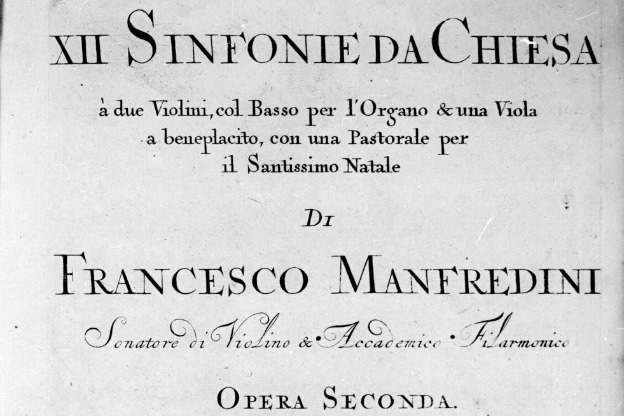
Francesco Onofrio Manfredini
Francesco Onofrio Manfredini, "papa" Manfredini, lived and died in Pistoia, Italy near Florence. He went to Bologna to learn violin with Torelli and study composition with Perti. Afterward, he spent a few years in Ferrara as a violinist in the orchestra and then landed a good job as a composer and performer for the Prince of Monaco. But in 1724, Francesco Manfredini moved back to his hometown, taking with him his growing family of six.
Once back in Pistoia, the Manfredini's had at least two if not three more children, and Francesco was doubtless glad to be able to support them all with his new job as the maestro di cappella at the cathedral. He composed numerous oratorios and lots of other sacred works while in that position-sadly these are all largely lost, and only his published instrumental music and a few manuscript sources survive.
Capricornus Consort Basel has recorded all of Francesco Manredini's Opus 2 Sinfonie da Chiesa in a 2014 release by Christophorus Records. Most of the set included on this recording are world premieres, so they are pieces you are unlikely to have heard before.
The Op. 2 collection was published for the first time in 1709 in Bologna and reprinted in 1711 by Estienne Roger in Amsterdam. Included were separate parts for the violins with solo indications, a part for the bowed bass, an organ part with chordal figures, and an optional viola part, making the performing forces needed for these pieces quite flexible. They can be performed several ways: one per part with viola, or as a standard trio sonata without viola, or as concerti grossi with multiple players doubling each part except in the sections marked solo. The title Sinfonie can then be seen as a sort of neutral term, encompassing all these possibilities for performance.
This music is characteristic of the Bologna fashion of composition, often with movements grouped slow-fast-slow-fast, with imitative or fugal elements abounding. And, you might be thinking that this music reminds you of Corelli, and you'd be right. Corelli and Manfredini-though different generations of composers-both studied in Bologna and had ties to San Petronio. Â And perhaps one other thing about Manfredini that will make you think of Corelli is his inclusion of a Christmas sinfonie at the end of the set.
Vincenzo Manfredini
Born in 1737, Vincenzo was one of the Manfredini sons born after the parent's return to Pistoia. And born just a few years after Haydn, Vincenzo Manfredini's string quartets-all six performed on a 2014 Brilliant Classics release by Quartetto Delfico-draw obvious comparisons to Haydn, the often credited ‘father of the string quartet.'
Papa Francesco was Vincenzo's first composition teacher, and then Vincenzo, like his father, went off to study in Bologna, and later Milan. But when another musician in the family-castrato Giuseppe Manfredini-got some work in St. Petersburg, Vincenzo tagged along.
Vincenzo filled the post of maestro di cappella for the court of Prince Pyotr Fedorovich, writing a number of operas and other small pieces. It was good work, but when a new Italian came to town, Baldassare Galuppi, Vincenzo lost some favor and eventually returned to Bologna in 1769.
Once back home, Vincenzo didn't compose as much and instead turned his attention toward writing extensively about music. Most significant were his books, Rules of Harmony and In Defense of Modern Music –the latter, a book that looked forward to the Romantic ideal of the merits of purely instrumental music, free from the constraints of language and words.









